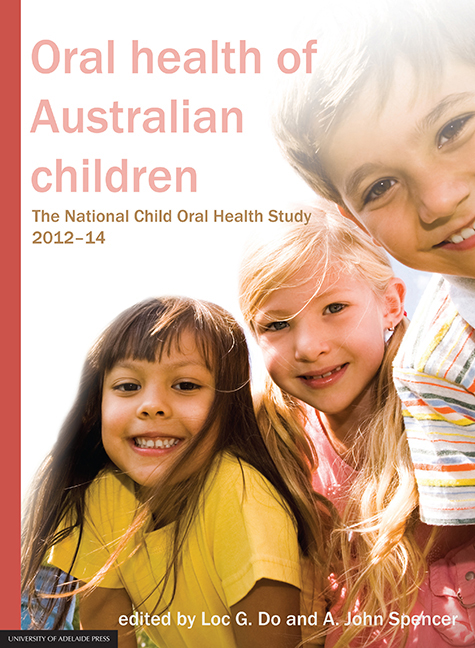Book contents
- Frontmatter
- List of Contributors
- Contents
- Preface
- Executive Summary
- 1 Children's oral health – assessing and improving oral health
- 2 Measuring child oral health and its influences
- 3 Data weighting, consideration and estimation procedures
- 4 Measuring representativeness of the study participants
- 5 Children's oral health status in Australia, 2012–14
- 6 Patterns of dental services use by Australian children
- 7 Australian children's oral health behaviours
- 8 Australian children's general health behaviours
- 9 Social gradients in child oral health
- 10 Oral health status and behaviours of Indigenous Australian children
- 11 Trends in child oral health in Australia
- 12 Interpretation of findings and a way forward to improving oral health and dental care
- 13 Appendix
- State and territory survey personnel
- Symbols
- Abbreviations
- Place names
- Glossary
- List of tables
- List of figures
9 - Social gradients in child oral health
Published online by Cambridge University Press: 05 September 2017
- Frontmatter
- List of Contributors
- Contents
- Preface
- Executive Summary
- 1 Children's oral health – assessing and improving oral health
- 2 Measuring child oral health and its influences
- 3 Data weighting, consideration and estimation procedures
- 4 Measuring representativeness of the study participants
- 5 Children's oral health status in Australia, 2012–14
- 6 Patterns of dental services use by Australian children
- 7 Australian children's oral health behaviours
- 8 Australian children's general health behaviours
- 9 Social gradients in child oral health
- 10 Oral health status and behaviours of Indigenous Australian children
- 11 Trends in child oral health in Australia
- 12 Interpretation of findings and a way forward to improving oral health and dental care
- 13 Appendix
- State and territory survey personnel
- Symbols
- Abbreviations
- Place names
- Glossary
- List of tables
- List of figures
Summary
Introduction
Health and behaviours are determined above all by social conditions (Sheiham et al. 2014) and for this reason social conditions in which people live have been considered as the cause of causes of diseases and health disorders (Braveman & Gottlieb 2014).
Differences in levels of oral health that disproportionally affect socially disadvantaged members of society and that are avoidable, unfair and unjust are defined as oral health inequalities. It is not only the difference between the rich and the poor but a consistent gradient across the social economic ladder that exists and is universally found (Watt et al. 2016). The huge extent of contemporary health inequalities has led to be termed as the plague of our era (Farmer 2001). Therefore, it is important to document and understand oral health inequalities in order to allow the implementation of the most appropriate oral health interventions.
There are several individual and area-based measures of socioeconomic position. This chapter presents Australia's child oral health outcomes according to parents’ educational level, household income, Index of Relative Socio-economic Advantage and Disadvantage (IRSAD) and Index of Community Socio-Educational Advantage (ICSEA).
Among several individual measures of socioeconomic position, income and education are most widely used. Education usually results from an individual's schooling until the beginning of the third decade of life, and has little variation from then on. Its impact can occur either in the increase of knowledge and ability to take on healthy habits or in their insertion in the job market, in better positions and with higher incomes (Lynch & Kaplan 2000).
Income is a useful measure of socioeconomic position because it is related directly to the material circumstances that may influence health and health-related behaviours (Lynch & Kaplan 2000).
The IRSAD summarises information about the economic and social conditions of people and households within an area, including both relative advantage and disadvantage measures. The average IRSAD value is 1000. A lower score indicates that an area is relatively disadvantaged compared to an area with a higher score (Australian Bureau of Statistics 2014).
The ICSEA is an index which combines students’ characteristics (such as parental occupation and level of education) and school's area characteristics such as proportion of Indigenous children and geographical location. The lower the ICSEA value, the lower the level of educational advantage of students who attend this school.
- Type
- Chapter
- Information
- Oral Health of Australian ChildrenThe National Child Oral Health Study 2012-14, pp. 237 - 263Publisher: The University of Adelaide PressPrint publication year: 2016



